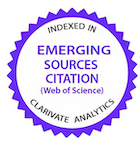Extrato etanólico de cascas recicladas de pequi (Caryocar brasiliense, Camb.) induz apoptose em células de osteossarcoma canino
DOI:
https://doi.org/10.1590/1809-6891v22e-71198Resumo
O osteossarcoma é uma neoplasia mesenquimal associada à alta mortalidade em cães e humanos. O pequi (Caryocar brasiliense, Camb.) é nativo do Cerrado, bioma rico em biodiversidade predominante na região Centro-Oeste do Brasil. Embora esta planta seja frequentemente utilizada na medicina popular, as propriedades farmacológicas da casca do pequi ainda são pouco conhecidas. Este estudo teve como objetivo determinar a atividade citotóxica do extrato etanólico de cascas de pequi recicladas em células de osteossarcoma canino. As células foram cultivadas e tratadas com concentrações finais de extrato de zero, 0,029 µg/µL, 0,29 µg/µL e 2,91 µg/µL por 24, 48 ou 72 horas. As células foram submetidas a ensaio de viabilidade celular pelos métodos de exclusão de azul de tripano da redução de tetrazólio para determinar a IC50, ao ensaio de sobrevivência celular para calcular a fração de sobrevivência e à dupla marcação com anexina V e iodeto de propídio para determinar o tipo de morte celular. O extrato etanólico de casca de pequi na concentração de 2,91 µg/µL apresentou a maior inibição do crescimento de células de osteossarcoma, com redução de 71,80% no crescimento em relação ao controle. A IC50 média foi de 155,2 μg/mL em 72 horas. O crescimento celular em 72 horas foi 3,33% menor nas células tratadas com 2,91 µg/µL de extrato. A apoptose foi o tipo predominante de morte celular em células tratadas com 2,91 µg/µL de extrato. Esses resultados demonstram que o extrato etanólico de cascas de pequi recicladas promove apoptose em células de osteossarcoma canino.
Palavras-chave: Antineoplásico; Cerrado; D-17; osteossarcoma canino; pequi; sustentabilidade; taninos.
Downloads
Referências
Wilk SS, Zabielska-Koczywas KA. Molecular mechanisms of canine osteosarcoma metastasis [Internet]. Vol. 22, International journal of molecular sciences. 2021. p. 3639. Available from: https://10.3390/ijms22073639
Leonardi L, Scotlandi K, Pettinari I, Benassi MS, Porcellato I, Pazzaglia L. Mirnas in canine and human osteosarcoma: A highlight review on comparative biomolecular aspects [Internet]. Vol. 10, Cells. 2021. p. 1–9. Available from: https://10.3390/cells10020428
Cortelo PC, Demarque DP, Dusi RG, Albernaz LC, Braz-Filho R, Goncharova EI, Bokesch HR, Gustafson KR, Beutler JA, Espindola LS. A molecular networking strategy: High-throughput screening and chemical analysis of brazilian cerrado plant extracts against cancer cells. Cells. 2021;10(3):1–13. Available from: https://10.3390/cells10030691
Palmeira SM, Silva PRP, Ferrão JSP, Ladd AABL, Dagli MLZ, Grisolia CK, Hernandez-Blazquez FJ. Chemopreventive effects of pequi oil (Caryocar brasiliense Camb.) on preneoplastic lesions in a mouse model of hepatocarcinogenesis. Eur J Cancer Prev. 2016;25(4):299–305. Available from: https://10.1097/CEJ.0000000000000187
Nunes C dos R, Arantes MB, de Faria Pereira SM, da Cruz LL, de Souza Passos M, de Moraes LP, Vieira IJC, de Oliveira DB. Plants as Sources of Anti-Inflammatory Agents [Internet]. Vol. 25, Molecules. 2020. p. 3726. Available from: https://10.3390/molecules25163726
Arnhold E. Package in the R environment for analysis of variance and complementary analyses. Brazilian J Vet Res Anim Sci. 2014;50(6):488–92. Available from: https://10.11606/issn.1678-4456.v50i6p488-492
De Oliveira CB, Comunello LN, Maciel ÉS, Giubel SR, Bruno AN, Chiela ECF, Lenz G, Gnoatto SCB, Buffon A, Gosmann G. The inhibitory effects of phenolic and terpenoid compounds from Baccharis trimera in SiHa cells: Differences in their activity and mechanism of action. Molecules. 2013;18(9):11022–32. Available from: https://10.3390/molecules180911022
Ullah A, Munir S, Badshah SL, Khan N, Ghani L, Poulson BG, Emwas AH, Jaremko M. Important flavonoids and their role as a therapeutic agent [Internet]. Vol. 25, Molecules. 2020. p. 5243. Available from: https://10.3390/molecules25225243
Felipe KB, Kviecinski MR, Da Silva FO, Bücker NF, Farias MS, Castro LSEPW, De Souza Grinevicius VMA, Motta NS, Correia JFG, Rossi MH, Pedrosa RC. Inhibition of tumor proliferation associated with cell cycle arrest caused by extract and fraction from Casearia sylvestris (Salicaceae). J Ethnopharmacol. 2014;155(3):1492–9. Available from: https://10.1016/j.jep.2014.07.040
Cunha BLA, de França JP, Moraes AA de FS, Chaves ALF, Gaiba S, Fontana R, do Sacramento CK, Ferreira LM, de França LP. Evaluation of antimicrobial and antitumoral activity of Garcinia mangostana L. (Mangosteen) grown in Southeast Brazil. Acta Cir Bras. 2014;29(suppl 2):21–8. Available from: https://10.1590/S0102-86502014001400005
Ozi JM, Suffredini IB, Paciencia M, Frana SA, Dib LL. In vitro cytotoxic effects of Brazilian plant extracts on squamous cell carcinoma of the oral cavity. Braz Oral Res. 2011;25(6):519–25.
Isani G, Bertocchi M, Andreani G, Farruggia G, Cappadone C, Salaroli R, Forni M, Bernardini C. Cytotoxic Effects of Artemisia annua L. And pure artemisinin on the D-17 canine osteosarcoma cell line. Oxid Med Cell Longev. 2019;2019. Available from: https://10.1155/2019/1615758
De Oliveira TS, Thomaz DV, da Silva Neri HF, Cerqueira LB, Garcia LF, Gil HPV, Pontarolo R, Campos FR, Costa EA, Dos Santos FCA, De Souza Gil E, Ghedini PC. Neuroprotective effect of caryocar brasiliense camb. leaves is associated with anticholinesterase and antioxidant properties. Oxid Med Cell Longev. 2018;2018:9842908. Available from: https://10.1155/2018/9842908
Eom T, Kim E, Kim JS. In vitro antioxidant, antiinflammation, and anticancer activities and anthraquinone content from rumex crispus root extract and fractions. Antioxidants. 2020;9(8):1–13. Available from: https://10.3390/antiox9080726
Spiegler V, Greiffer L, Jacobtorweihen J, Asase A, Lanvers-Kaminsky C, Hempel G, Agyare C, Hensel A. In vitro screening of plant extracts traditionally used as cancer remedies in Ghana – 15-Hydroxyangustilobine A as the active principle in Alstonia boonei leaves. J Ethnopharmacol. 2021;265:113359. Available from: https://10.1016/j.jep.2020.113359
Ke H, Wang X, Zhou Z, Ai W, Wu Z, Zhang Y. Effect of weimaining on apoptosis and Caspase-3 expression in a breast cancer mouse model. J Ethnopharmacol. 2021;264:113363. Available from: https://10.1016/j.jep.2020.113363
Henklewska M, Pawlak A, Kutkowska J, Pruchnik H, Rapak A, Obminska-Mrukowicz B. In vitro effects of the activity of novel platinum (II) complex in canine and human cell lines. Vet Comp Oncol. 2019;17(4):497–506. Available from: https://10.1111/vco.12511
Shehata MG, Abu-Serie MM, Abd El-Aziz NM, El-Sohaimy SA. Nutritional, phytochemical, and in vitro anticancer potential of sugar apple (Annona squamosa) fruits. Sci Rep. 2021;11(1):6224. Available from: https://10.1038/s41598-021-85772-8
Chang Z, Jian P, Zhang Q, Liang W, Zhou K, Hu Q, Liu Y, Liu R, Zhang L. Tannins in: Terminalia bellirica inhibit hepatocellular carcinoma growth by regulating EGFR-signaling and tumor immunity. Food Funct. 2021;12(8):3720–39. Available from: https://10.1039/d1fo00203a
Yang HL, Liu HW, Shrestha S, Thiyagarajan V, Huang HC, Hseu YC. Antrodia Salmonea Induces Apoptosis and Enhances Cytoprotective Autophagy in Colon Cancer Cells. Aging (Albany NY). 2021;13(12):15964–89. Available from: https://10.18632/aging.203019
Chaudhry GES, Islamiah M, Zafar MN, Bakar K, Aziz NA, Saidin J, Sung YY, Muhammad TST. Induction of Apoptosis by Acanthaster planci sp., and Diadema setosum sp., Fractions in Human Cervical Cancer Cell Line, HeLa. Asian Pacific J Cancer Prev. 2021;22(5):1365–73. Available from: https://10.31557/APJCP.2021.22.5.1365
Ryu S, Park S, Lim W, Song G. Effects of luteolin on canine osteosarcoma: Suppression of cell proliferation and synergy with cisplatin. J Cell Physiol. 2019;234(6):9504–14. Available from: https://10.1002/jcp.27638
Park H, Park S, Bazer FW, Lim W, Song G. Myricetin treatment induces apoptosis in canine osteosarcoma cells by inducing DNA fragmentation, disrupting redox homeostasis, and mediating loss of mitochondrial membrane potential. J Cell Physiol. 2018;233(9):7457–66. Available from: https://10.1002/jcp.26598
Levine CB, Bayle J, Biourge V, Wakshlag JJ. Cellular effects of a turmeric root and rosemary leaf extract on canine neoplastic cell lines. BMC Vet Res. 2017;13(1). Available from: https://10.1186/s12917-017-1302-2
Jiang X, Wang X. Cytochrome C-mediated apoptosis [Internet]. Vol. 73, Annual Review of Biochemistry. 2004. p. 87–106. Available from: https://10.1146/annurev.biochem.73.011303.073706
Cruz VS, Rodrigues FA, Braga KMS, Machado PA, Filho CB, Prado YCL, Araújo EG. β Lapachone blocks the cell cycle and induces apoptosis in canine osteosarcoma cells1. Pesqui Vet Bras. 2018;38(12):2224–32. Available from: https://10.1590/1678-5150-PVB-5524
Soares NP, Nepomuceno LL, Cruz V de S, Arnhold E, Vieira V de S, Borges JC de A, Pereira DKS, Pereira KF, Araújo EG de. Curcumina promove apoptose extrínseca em células de osteossarcoma canino. Res Soc Dev. 2020;9(10):e7289109231. Available from: https://10.33448/rsd-v9i10.9231
Mans DRA, Rocha AB, Schwartsmann G. Anti‐Cancer Drug Discovery and Development in Brazil: Targeted Plant Collection as a Rational Strategy to Acquire Candidate Anti‐Cancer Compounds. Oncologist. 2000;5(3):185–98. Available from: https://10.1634/theoncologist.5-3-185
Downloads
Publicado
Como Citar
Edição
Seção
Licença
Copyright (c) 2022 Ciência Animal Brasileira

Este trabalho está licenciado sob uma licença Creative Commons Attribution 4.0 International License.
Autores que publicam nesta revista concordam com os seguintes termos:
- Autores mantém os direitos autorais e concedem à revista o direito de primeira publicação, com o trabalho simultaneamente licenciado sob a Licença Creative Commons Attribution que permite o compartilhamento do trabalho com reconhecimento da autoria e publicação inicial nesta revista.
- Autores têm autorização para assumir contratos adicionais separadamente, para distribuição não-exclusiva da versão do trabalho publicada nesta revista (ex.: publicar em repositório institucional ou como capítulo de livro), com reconhecimento de autoria e publicação inicial nesta revista.
- Autores têm permissão e são estimulados a publicar e distribuir seu trabalho online (ex.: em repositórios institucionais ou na sua página pessoal) a qualquer ponto antes ou durante o processo editorial, já que isso pode gerar alterações produtivas, bem como aumentar o impacto e a citação do trabalho publicado (Veja O Efeito do Acesso Livre).






























